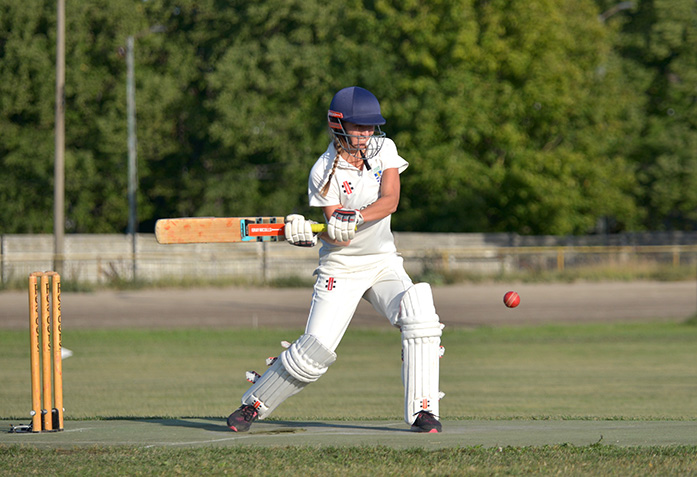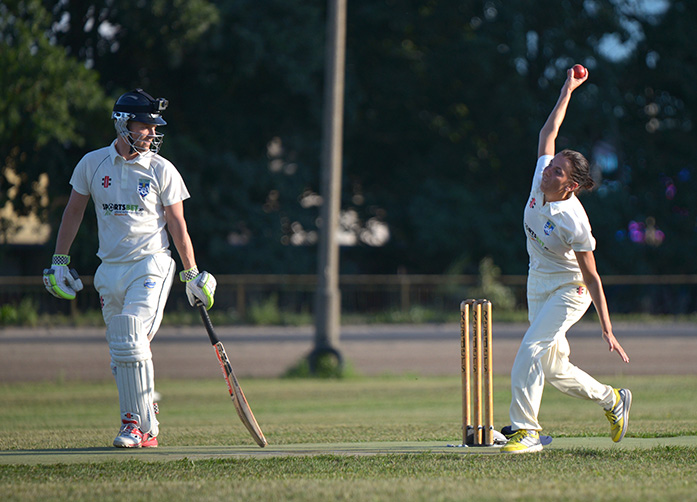Go-Far 2018

Ms Pilleriin Vessik, 28, bats in a Super 8 league game. She has been playing cricket for five years.
Cricket-lite makes a home run
Modified rules score with locals
Story and photos by Khairul Anwar
CRICKET enthusiast Annemari Vessik cheered along with more than 90,000 fans during a 2013 Boxing Day Test match between Australia and England at the Melbourne Cricket Ground. The attendance set the world record for the most number of people watching cricket in a stadium.
The 33-year-old, who in 2015 was elected the Estonian Cricket Association (ECA)’s first female president, said: “It was exciting to see the big stars playing and hear the crowd cheering. We can’t get this kind of experience in Estonia because we do not have enough people.”
“It made me think about how to make cricket more appealing to play,” added Ms Vessik, who has been playing cricket for nine years.
There are some 120 active cricketers in Estonia, more than half of them expats, but Ms Vessik and the ECA are pulling out all the stops to increase their numbers and attract more locals to play.
Changing the rules

Ms Annemari Vessik bowls in a Super 8 league game.
While Pilleriin is better at batting, Annemari is better at bowling, said Pilleriin.
There are three formats of cricket recognised by the International Cricket Council (ICC), which last five days, eight hours and four hours respectively. Estonians often find them long and tiresome, said the ECA.
In 2013, the association created a version of cricket that lasts for only two hours, naming it “Super 8”, after the number of players per team. In contrast, the other formats recognised by the ICC are made up of 11 players per team.
Ms Vessik, who holds a full-time job as lead assistant of a logistics team, said: “We made the Super 8 more convenient and simple, so when the new players come in, they’re not confused by all the rules.”
The Super 8 format is played by men, women and juniors with various skill levels. This is unlike the three ICC-recognised formats, which require all-male or all-female teams.
In winter, when temperatures range from minus 25 deg C to 5 deg C, cricket is played indoors in schools’ multi-purpose halls. The winter version of cricket involves a different set of rules to develop cricketers’ technique.
Estonia’s efforts to change the rules of the game seem to be paying off.
It attracted enough players to form the Estonian national team and play in regional tournaments such as the annual Central European Natives Cricket Cup. Estonia has been crowned champion thrice — in 2015, 2017 and 2018.
The cup is a mixed tournament organised by the Warsaw Hussars Cricket Club, and only natives of its participating countries are allowed to play.
Future plans
Looking ahead, the ECA is channelling more funds and manpower towards building a new playing ground, slated for completion next September. The association’s current playing grounds is at the Tallinna Hipodroom, a traditional harness racing track.
Cricket will have a new home, with proper toilets and changing facilities as well as a clubhouse where players and visitors can mingle. The new venue will help to build a stronger foundation for cricket in Estonia, said Ms Vessik.
She hopes that the Estonian national cricket team will be able to play in bigger international tournaments and for cricket to be more well-received by locals. But it is more important, she added, to first develop the sport.
She said: “You can have the top teams but if you don’t have anything underneath it, it doesn’t matter.”